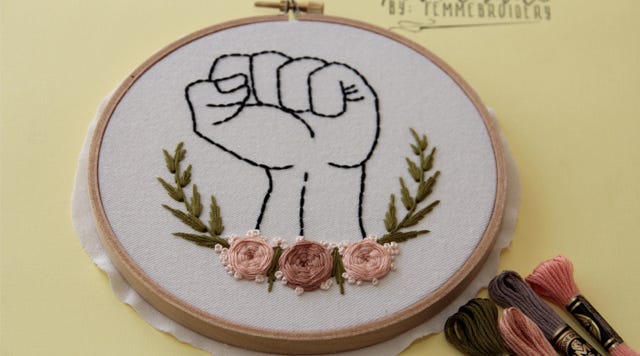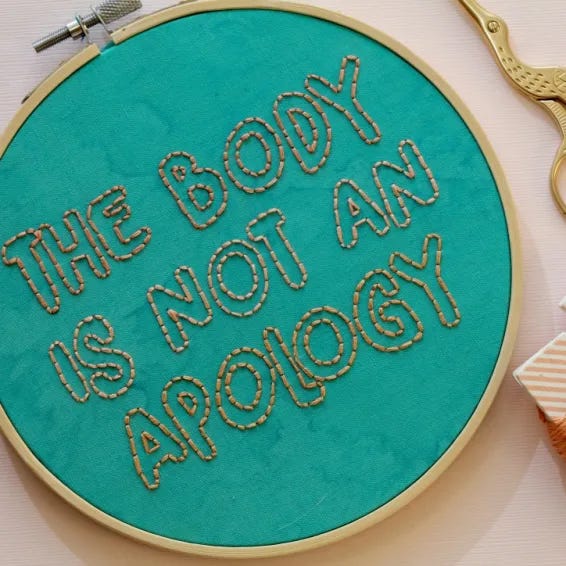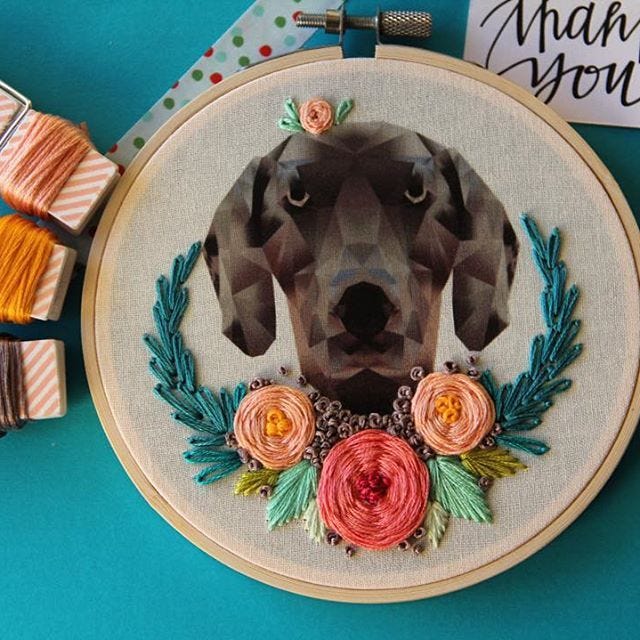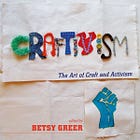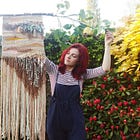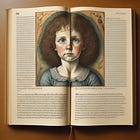Art+Psychology Interview with Maria Arseniuk of Femmebroidery
I really enjoy using embroidery as a medium because it’s been conceptualized as a traditionally women’s medium ...I really enjoy the marriage of the crass or the obscene with lighter, floral patterns.
This interview was originally published in 2016 by Fempotential. It has not been updated before re-publication and we should not presume that the artist feels the exact same way about everything today. Humans change and grow. Regardless, the words and work are powerful.
Maria Arseniuk is a Canadian artist who works at the intersection of feminism and fiber art, selling her work under the name Femmebroidery. She was a Women’s Studies major who began exploring embroidery as a hands-on distraction from the intellectual demands of grad school. Upon graduation, she began working in craft full-time, incorporating mixed media into her art in collaboration with her partner, a designer who helps her with her custom pet portraits. In this interview she shares the pros and cons of expanding her art beyond feminism / craftivism while still holding that perspective at the core of what she does.
Kathryn: When and how did you learn embroidery?
Maria: I began when I was 11 after a friend of my mother’s gave me a book of stitches. I was really fascinated by all of the combinations you could create with various threads and stitches and immediately became addicted. Now at 28, it’s still my favorite craft!
Kathryn: What other crafts do you enjoy?
Maria: I do film and digital photography, and I would love to get into printmaking. One of these days I will work up the courage to try something new and I’ll delve into the world of linocut blocks. And weaving. I would love to try weaving. I’ve also bought a pattern to sew a dress, so there’s that too.
Kathryn: There are so many great crafts to try, aren’t there? Is anyone else in your family a crafter?
Maria: Nope! Just me. No one else in my family is even into the visual arts or textiles. Although there is some interest in performance arts; in her youth my mother was a dancer in the Soviet ensemble and traveled across Europe with her troupe. I also have a cousin who is a violinist in the national orchestra.
Kathryn: You enjoy embroidery as not just a craft but as an expression of feminism. What can you tell us about that?
Maria: I really enjoy using embroidery as a medium because it’s been conceptualized as a traditionally women’s medium and generally only used for feminine, delicate detailing – like on tapestry. I really enjoy the marriage of the crass or the obscene with lighter, floral patterns.
Kathryn: That contrast adds humor to a sometimes “heavy” subject. What was your own journey with claiming the title of being a feminist?
Maria: I’ve never struggled with this word or title. I remember being 11 or 12 and buying a used copy of Seventeen Magazine from the thrift shop; there was an article in it about feminism and I remember reading about it and thinking, “yes, that’s me”. Prior to that I didn’t know that there existed language to describe the ways in which I thought and felt; that article created a space for me to explore a ‘new’ identity.
I know some people prefer the terms ‘humanist’ or ‘egalitarian’, but for me feminism has always been at the forefront of how I view myself and my relationships and has been the ‘tool kit’ of how to understand the various forms of oppression around us. While it’s true that there is so much more to oppression and marginalization than gender (including race, class, sexuality, ability, citizenship …) for me, intersectional feminism addresses all of these issues.
While I would never shame another person for rejecting the title of feminist, I think it’s really important to have these discussions about where words and titles come from, their histories and why it’s important to carry these terms into the future as movements evolve.
In an interview with A Quarter Young, Maria explains why her graduate degree in Women’s Studies was important: “I was and still am incredibly passionate about social justice. I wanted to learn more about the kinds of things I was reading about in the media and researching for myself online. I wanted to have the language to describe the things I was living and the experiences my friends were living when we didn’t have the tools to call out discrimination and systemic injustice for what it was.”
Kathryn: Absolutely. Your artwork is an expression of feminism as well as a form of craftivism. And you donate money from your artwork to the causes close to you right, particular Black Lives Matter?
Maria: Yes, I personally use craftivism as a way to invest in or give back to communities. Some of my pieces come with an automatic $10 donation to BLM. For me (and I say this as an ally, as a white woman who’s never experienced racism or discrimination firsthand), BLM is the continuation of the Civil Rights movement. I think the more you learn about existing racial segregation & police violence (a great book about this issue is Michelle Alexander’s ‘The New Jim Crow‘) the more crucial it is to become familiar with the movement and its goals.
Racial profiling in Stop and Frisk is unacceptable, the disproportionate composition of jails and prisons as Black and Latino is unacceptable, the discrimination against people of color in schools, higher education and the workforce is unacceptable. I think a lot of the misunderstandings stem from the issue that white folks understand BLM as “Black Lives Matter MORE” or “Only Black Lives Matter” – which is not the case. BLM is literally just saying ‘please stop killing us’, our lives matter TOO. I think this sentiment is made especially clear when we look at police brutality; it’s not that police need to learn how to not shoot (police do just fine at not shooting white folks, even when those white folks are people like Dylan Roof); police need to learn how to not view Blackness as a threat.
Kathryn: The state of the world can be so overwhelming with so much injustice … what advice can you offer to young women who want to make a difference in the world?
Maria: The state of the world is definitely overwhelming. I usually have a good cry about it all at least once a week. My advice to other young women seeking to create positive change is to keep at. Find out what you’re passionate about (veganism? disability rights? body positivity?), get educated about the topic and use that as your voice.
I find that it can be very tempting to appeal to people’s emotions, and I myself get emotional about the subjects I care deeply about. However, it becomes incredibly easy to be dismissed when you lack any factual foundation to back up your claims. Here is an example. Let’s say that you’re confronted with the comment, “Refugees are coming in hordes, cheating our system, and bleeding our welfare dry while breeding terrorists”. It is tempting to reply with, “refugees deserve fair and just treatment”. While this is true (that refugees deserve fair and just treatment), it doesn’t combat any of the misconceptions you’ve been presented with. If instead, you have educated yourself with the issue and can reply with, “Well actually, the current influx of refugees reflects only 0.011% of Canada’s population, the budget for refugee resettlement over the course of 6 years is $1.2B, which amounts to only 0.07% of the federal budget, and there has never been a terrorist attack on Canadian soil by a foreign-born person, citizen or otherwise” then you’ve shut down every facet of the initial comment with facts and knowledge that directly contradict the prejudice. While it’s difficult (for me at least) to stay calm in the face of bigotry, racism and/or xenophobia, I think it’s our responsibility, as people in positions of privilege to create resistance.
Note: Maria puts her money where her mouth is, in addition to her donations to BLM, she donated 10% of all sales during last year’s holiday markets to Newfound Friends, a Canadian non-profit that welcomes and resettles Syrian refugees.
Kathryn: As your work has expanded to embrace new themes (animals, pop culture, etc.), what would you say is the message that runs through it all?
Maria: I’ve really struggled with the expansion. If I could, I would use art solely as a social commentary about feminism and activism. That being said, I have to create an income and pay my mortgage and my taxes and my bills so I’ve expanded to other themes. The pop culture ones generally stay with the theme of strong women, so the wildlife and nature ones are a little left field, but it does allow for a little more diversity and variety in my work and it also appeals to a larger clientele. That being said, I am my most comfortable in the outdoors and I do love nature – so it’s not that those embroideries outside of feminism/activism are ‘not me’, it’s just that I just get disappointed at how much more popular those are than the more political work.
Kathryn: In terms of pop culture, one of the women your work regularly references is Beyonce. What inspires you about her?
Maria: She’s created an empire and she’s always been incredibly unapologetic. I think she’s fierce and proud and strong and I admire her for using her fame as a stage to comment on current affairs. Plus, she’s a babe – how could you not like her?
Kathryn: Who are some of your other role models?
Maria: My mother and stepmother, who are both incredibly strong willed women who never let the man get them down.
If you have read this far, remember that writing takes much longer than reading. Support the work by paying for it. My Sliding Scale annual rate starts at $10.



